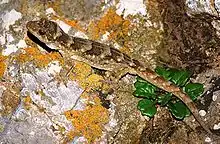Alfred Duvaucel
Alfred Duvaucel (1793, Évreux, Eure – 1824, Madras, India) was a French naturalist and explorer. He was the stepson of Georges Cuvier.
Journeys in South and Southeast Asia
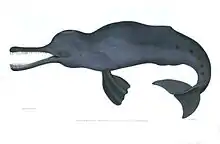
In December 1817, Duvaucel left France for British India and arrived in Calcutta in May 1818, where he met Pierre-Médard Diard. Together, they moved to Chandernagore, then a trading post of the French East India Company, and started collecting animals and plants for the Paris Museum of Natural History. They employed hunters who supplied them daily with live and dead specimens, which they described, drew and classified. They also received objects from local rajahs and went hunting themselves. In the garden of their compound, they cultivated local plants and kept water birds in a basin. In June 1818, they sent their first consignment to Paris, containing a skeleton of a Ganges river dolphin, a head of a "Tibetan ox", various species of little-known birds, some mineral samples and a drawing of a tapir from Sumatra that they had studied in Hastings' menagerie. Later consignments included a live Cashmere goat, crested pheasants and various birds.[1][2]
In December 1818, Thomas Stamford Raffles invited them to accompany him on his journeys and pursue their collections in places where he would have to go officially. He offered to establish a menagerie in his Bencoulen residence. By end of December, they left with him on the basis they would equally share the collected animals. In Pulo-Pinang, they collected two new fish species and some birds. In Achem, they collected only a few plants, insects, birds, snakes, fish and two deer. In Malacca, they bought a bear, an argus and some other birds. In Singapore, they obtained a dugong, of which they prepared drawings and a description that Raffles sent to the Royal Society. These were published in 1820 by Everard Home and planned for publication in the Histoire naturelle des mammifères by Étienne Geoffroy Saint-Hilaire and Frédéric Cuvier. After their arrival at Bencoulen in August 1819, Raffles requisitioned most of their collection and left them copies of their drawings, descriptions and notes. Duvaucel and Diard took leave, sent their share to Calcutta and parted.[1]
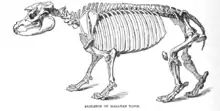
Duvaucel set off to Padang, and collected specimens of the Malayan tapir, Sumatran rhinoceros, several monkeys, reptiles, deer and axis in this area. He returned to Calcutta with several cases of stuffed animals, skeletons, skins and some live monkeys.[1]
He returned to Chandernagore, from where he made several excursions. In July 1821, he embarked on the Hooghly River, visited the cities of Hooghly and Guptipara, and moved on across the Ganges to Dacca. From there he traveled to Sylhet and, with permission of a Khasi king, explored the mountains of Cossy and Gentya north of Sylhet. He returned to Calcutta in December with a rich zoological collection, but since then he suffered from the jungle fever. He intended to set off to Tibet in September 1822.[3][4] But due to political circumstances, he had to restrict his excursions to the territories of Benares in Bengal, and Kathmandu in "Nepaul". There is no record however that he ever traveled to Nepal,[5] and the editor of the Journal of the Asiatic Society of Bengal noted in 1836 that two of Duvaucel's collectors lived for a year with Brian Houghton Hodgson at Kathmandu.[6]
Duvaucel died in August 1824 in Madras, but his obituary was not published until April 1825.[7] Ten years later, rumours were afloat in France that he was mauled by a tiger within minutes.[8]
Publications
In February 1820, the Asiatick Society (Calcutta, India) published an article jointly written by Duvaucel and Diard entitled "Sur une nouvelle espèce de Sorex — Sorex Glis" including a drawing of a common treeshrew.[9]
In spring 1822, the Asiatick Society published his article "On the Black Deer of Bengal" including a drawing of a deer species that he had observed in Bengal, Sumatra, and in the mountains north of Sylhet.[10]
Legacy
The Paris Museum of Natural History received nearly 2000 animals collected jointly by Duvaucel and Diard during their stay of more than a year in the Greater Sunda Islands. Their consignments comprised 88 mammal species, 630 bird species, 59 reptile species and contained stuffed animals, skins, skeletons, drawings and descriptions of such notable species as the Malayan tapir, Sumatran rhinoceros, Javan rhinoceros, gibbons, leaf monkeys, two previously unknown fruit bat species, tree shrews, skunks, binturong and sun bear.[11] Several of these species were first described by French zoologists working at the museum. Anselme Gaëtan Desmarest described the Malayan tapir in 1819; the Sunda stink badger and Paradoxurus hermaphroditus bondar, a subspecies of the Asian palm civet in 1820; the Sunda pangolin, the Malayan weasel and the genus of Semnopithecus in 1822.
In 1821, Raffles published descriptions of the species jointly collected by Duvaucel and Diard in Sumatra, including first descriptions of the sun bear, the binturong, the crab-eating macaque, the Sumatran surili, the siamang gibbon, the silvery lutung, the large bamboo rat, the large treeshrew and the cream-coloured giant squirrel.[12]
The many drawings, skeletons, skins and other animal parts that Duvaucel sent to the Paris Museum of Natural History included head, skin and paws of a species from the mountains north of India that his stepfather's brother Frédéric Cuvier described as Ailurus fulgens in 1825.[13][14]
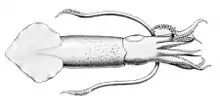
Alfred Duvaucel is commemorated in the scientific names of a number of species:
- the barasingha Cervus duvaucelii — described by his stepfather Georges Cuvier in 1823;[15]
- the scarlet-rumped trogon Harpactes duvaucelii — described by Coenraad Jacob Temminck in 1824;
- the river lapwing Vanellus duvaucelii — described by Rene Primevere Lesson in 1826;
- the Himalayan goral Naemorhedus duvaucelii — described by Charles Hamilton Smith in 1827 is synonymous to Naemorhedus goral described in 1825 by Thomas Hardwicke;[16]
- the Pachysoma duvaucelii, a subspecies of the lesser short-nosed fruit bat — described by Isidore Geoffroy Saint-Hilaire in 1828;
- the moth Psichotoe duvaucelii — described by Jean Baptiste Boisduval in 1829;[17]
- Duvaucel's barbet Megalaima australis duvaucelii — first described as Bucco duvauceli by René Primevère Lesson in 1831 as living in Sumatra;[18] relegated a subspecies of Xantholæma duvaucelii described by Thomas Horsfield and Frederic Moore in 1856 as inhabiting the Malayan Peninsula and Sumatra;[19] latter was renamed Megalaima duvaucelii by Frederic Moore in 1859[20] and subordinated to Mesobucco duvauceli by George Ernest Shelley in 1891;[21] the bird is now a valid subspecies of the blue-eared barbet;[22]
- Duvaucel's cuckoo Bubutus duvaucelii — described by Lesson in 1831 as living in Sumatra;[23] subordinated to the genus Rhinortha by Shelley in 1891 as a type of Raffles's malkoha;[24]
- the Indian squid Loligo duvaucelii — described by Alcide d'Orbigny in 1835 is a synonym of Uroteuthis duvauceli;[25]
- Duvaucel's gecko Hoplodactylus duvaucelii — described by André Marie Constant Duméril and Gabriel Bibron in 1836;[26]
- the Indian bee species Macrocera duvaucelii — described by Amédée Louis Michel Lepeletier in 1842 is synonymous to Tetralonia duvaucelii;[27]
- the freshwater fish Rohita duvaucelii — described by Achille Valenciennes in 1842 is a junior synonym of Osteobrama vigorsii endemic to India;[28]
- the olive barb Barbus duvaucelii — described by Valenciennes in 1842 is a junior synonym of Puntius sarana;[29]
- the pool barb Leuciscus duvaucelii — described by Valenciennes in 1844 is a junior synonym of Puntius sophore;[30]
- the nase Chondrostoma duvaucelii found near Madras — first described by Valenciennes in 1844;[31]
- Felis Duvaucelli — described by Brian Houghton Hodgson in 1852, was renamed Felis charltoni by Thomas Horsfield in 1856;[32] and classified a subspecies of Pardofelis marmorata by Reginald Innes Pocock in 1932;[33]
- Cyanops duvauceli robinsoni — named by Edward Charles Stuart Baker in 1918 as inhabiting the Malay Peninsula, Thailand and Myanmar,[34] is another name for the blue-eared barbet.
References
- Cuvier, G. (1821). "Notice sur les voyages de MM Diard et Duvaucel, naturalistes français, dans les Indes orientales et dans les îles de la Sonde". Revue encyclopédique. X (Juin 1821): 472–482.
- Anonymous (1824). "Notice sur le voyage de M. A. Duvaucel, dans l'Inde". Journal Asiatique. Société Asiatique. IV (Mars 1824): 137–145.
- Cuvier, F. (1824). "Notices sur les voyages de M. Duvaucel". Revue encyclopédique. XXI (Février 1824): 257–267.
- Anonymous (1824). "Notice sur le voyage de M. A. Duvaucel, dans l'Inde". Journal Asiatique. Société Asiatique. IV (Avril 1824): 200–213.
- Weiss, C. (1841). Biographie universelle, ou Dictionnaire historique contenant la nécrologie des hommes célèbres de tous les pays. Volume 2. Paris: Furne. p. 469.
- Anonymous (1836). "Note on the Cervus Duvaucelii of Cuvier, or C. Elaphoides and Bahraiya of Hodgson". Journal of the Asiatic Society of Bengal. 5: 240–242.
- Anonymous (1825). "Nécrologie: Duvaucel". Revue encyclopédique. XXVI (Avril 1825): 274.
- Eyriès, J. B.; Malte-Brun, C. (1835). Nouvelles annales des voyages, de la géographie et de l'histoire. Volume 66, Troisième série. Gide fils, Arthus Bertrand. Paris. p. 376.
- Diard, P.M., Duvaucel, A. (1820) "Sur une nouvelle espèce de Sorex — Sorex Glis". Asiatick researches, or, Transactions of the society instituted in Bengal, for inquiring into the history and antiquities, the arts, sciences, and literature of Asia, Volume 14. Bengal Military Orphans Press, 1822
- Duvaucel, A. (1822) "On the Black Deer of Bengal". Asiatick researches, or, Transactions of the society instituted in Bengal, for inquiring into the history and antiquities, the arts, sciences, and literature of Asia, Volume 15. Bengal Military Orphans Press, 1825
- Anonymous (1824). "Troisieme Notice sur le voyage de M. A. Duvaucel, dans l'Inde, ayant pour objet plus particulier, l'histoire naturelle". Journal Asiatique. Société Asiatique. IV (Novembre 1824): 277–285.
- Raffles, T. S. (1821). "Descriptive Catalogue of a Zoological Collection made on account of the Honourable East India Company, in the Island of Sumatra and its Vicinity, under the Direction of Sir Thomas Stamford Raffles, Lieutenant-Governor of Fort Marlborough; with additional Notices illustrative of the Natural History of those Countries". The Transactions of the Linnean Society of London. Linnean Society of London. XIII: 239–340.
- Cuvier, F. (1825) "Ailurus. Ailurus fulgens. Panda". (archived from the original on January 13, 2013) 3 pages, 1 plate. In: Geoffroy Saint-Hilaire, E.; Cuvier, F. (eds.) Histoire naturelle des Mammifères, avec des figures originales, coloriées, dessinées d'après des animaux vivans: publié sous l'autorité de l'administration du Muséum d'Histoire naturelle (50). A. Belin, Paris
- Cuvier, Georges (1829) Le règne animal distribué d'après son organisation, Tome 1 Chez Déterville, Paris book preview page 138: Le Panda éclatant
- Cuvier, G. (1823). Recherches sur les ossemens fossiles de quadrupèdes. Nouvelle édition, Tome Quatrième. Dufour & d'Ocagne, Paris, Amsterdam.
- Wilson, D. E., Reeder, D.M. (2005) Mammal species of the world: a taxonomic and geographic reference, Volume 1 page 706: Naemorhedus goral Johns Hopkins University Press, 2005
- Boisduval, J. P. (1829). "Psichotoe duvaucelii". Essai sur une Monographie des Zygénides, suivi du tableau méthodique, des Lépidoptéres d'Europe. Bruxelles: Méquignon-Marvis, Crochard. p. 129, plate 8.
- Lesson, R.P. (1831) Traité d'ornithologie, ou, Tableau méthodique des ordres, sous-ordres, familles, tribus, genres, sous-genres et races d'oiseaux page 164: Barbu de Duvaucel Bucco duvauceli F.G. Levrault, Paris
- Horsfield, T. (1856) A Catalogue of the Birds in the Museum of the Hon. East-India Company, Vol. II, page 647. WM H. Allen and Co., London
- Moore, F. (1859) List of Malayan Birds collected by Theodore Cantor Megalaima duvaucelii Proceedings of the Zoological Society of London (Volume 1859), page 455. Zoological Society of London
- Catalogue of the birds in the British Museum Mesobucco duvauceli Volume XIX, page 85. British Museum (Natural History), London
- Integrated Taxonomic Information System Megalaima australis duvaucelii
- Lesson, R.P. (1831) Traité d'ornithologie, ou, Tableau méthodique des ordres, sous-ordres, familles, tribus, genres, sous-genres et races d'oiseaux page 143: Boudou de Duvaucel Bubutus duvaucelii F.G. Levrault, Paris
- Shelley, G.E. (1891) Catalogue of the birds in the British Museum Rhinortha Volume XIX, page 393. British Museum (Natural History), London
- Global Biodiversity Information Facility Uroteuthis duvauceli
- Beolens, Bo; Watkins, Michael; Grayson, Michael (2011). The Eponym Dictionary of Reptiles. Baltimore: Johns Hopkins University Press. xiii + 296 pp. ISBN 978-1-4214-0135-5. ("Duvaucel", p. 79).
- Gray, J. E. (1853) Catalogue of hymenopterous insects in the collection of the British Museum. Part II Apidæ page 302: Tetralonia Duvaucelii. British Museum, London
- FishBase 2010 Rohita duvaucelii Valenciennes, 1842
- FishBase 2010 Barbus duvaucelii Valenciennes, 1842
- FishBase 2010 Leuciscus duvaucelii Valenciennes, 1844
- Catalog of fishes 2011 Chondrostoma duvaucelii Archived 2012-10-18 at the Wayback Machine California Academy of Sciences Research
- Horsfield, T. (1856) Catalogue of a collection of Mammalia from Nepal, Sikim, and Tibet, presented to the Hon. East India Company by B. H. Hodgson, Esq., in 1853. Proceedings of the Zoological Society of London, Part XXIV: 396
- Pocock, R. I. (1939) The Fauna of British India, Including Ceylon and Burma. Mammalia. – Volume 1. Taylor and Francis, London.
- Stuart Baker, E.C. (1918) Cyanops duvaceli robinsoni. Bulletin of the British Ornithologist's Club, Vol. XXXIX: 20

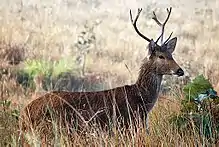
_-_pair.jpg.webp)
